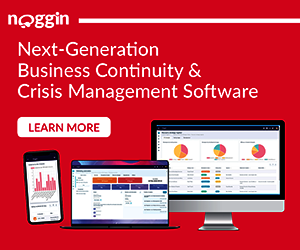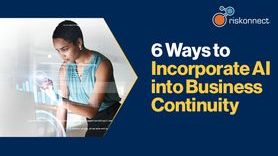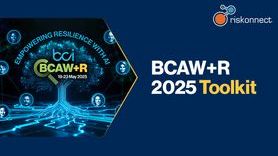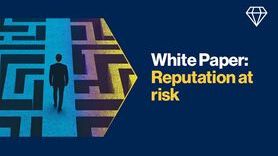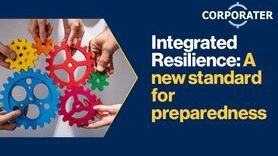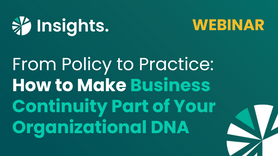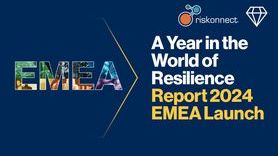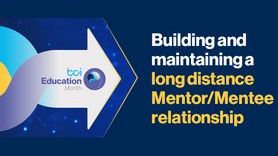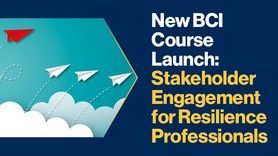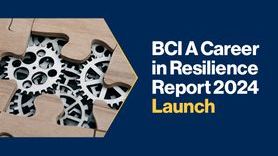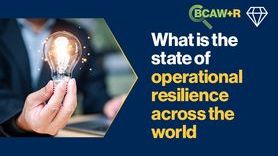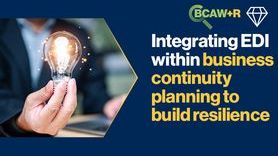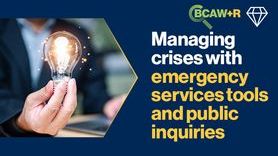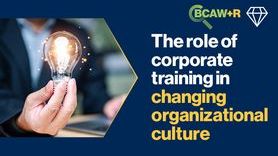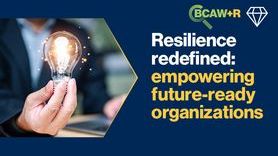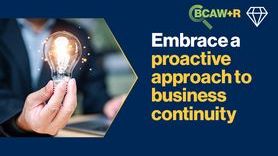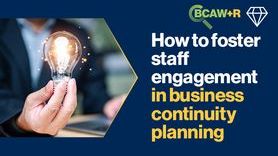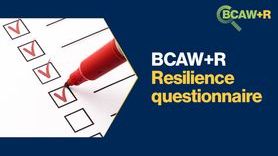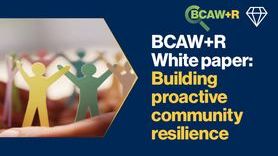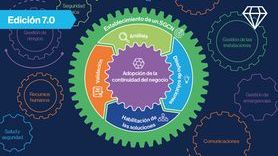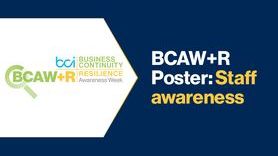BCI World Hybrid 2022: First time attending

BCI World Hybrid was successfully held last week and, as Content Creator for the BCI, it was exciting to attend my first in-person event in this sector. It meant I had the chance to meet attendees while listening to leaders in this sector discuss the trends and topics that concern us all. The dynamic presentations, panel discussions and workshops all provided a different take and flavour on the key theme of ‘24-hours of Resilience.’ Throughout the physical event, it was easy to see the energy and interest in the room for this topic, with many different perspectives coming together to further the discussion. It is something I have taken back into my role at the BCI, as we continue to prepare new content for members.
It was also enjoyable to see how its hybrid nature reflected the wider trends of working we have all seen brewing during and after the COVID-19 pandemic, where physical networking and interacting with colleagues works alongside an additional flexibility and accessibility for an international audience. Indeed, this year saw BCI World combine a physical conference in London, with keynote sessions live-streamed to the rest of the world, alongside four other streams covering a variety of different topics, as part of a 24-hour virtual conference. As a result, attendees had the opportunity to access nearly 100 hours of content. If anything was missed, some of this content will also be available for 30 days, accessible on-demand.
Showing a return on investment
Opening the event schedule, Charlie Maclean-Bristol FBCI of PlanB Consulting took a look at “Measuring return on investment (ROI) in business continuity spending.” Charlie opened up his session by explaining the difficulties of applying traditional forms of showing a ROI, such as cost-benefit analysis, to this sector, as it is difficult to measure the performance of a Business Continuity solution over time (as an event that proves the efficacy of the solution may/may not occur for some time). Therefore, Charlie proposed that investment should be placed in the people responsible for BC, with their performance becoming the measurable component of a ROI. He highlighted the strength of this point by providing a few brief case studies of leadership in emergency response situations, with some rising to the occasion and some who may have put in a better performance had they been properly trained – a sadly timely topic.
This then raises the question of how we can assess key competencies in staff before an event occurs. Once we know this, we can tailor training to what they need to know and get them up to speed so they are ready for an incident. Charlie uses a qualitative self-assessment questionnaire with around 20-30 questions to gather this information. From this, he creates a baseline of scores for key actions/behaviours, such as knowledge, experience and incident management skills. He adds that the requirements to improving a staff member’s scores are either “time, expertise or budget.” With regards to how this leads to showing ROI, Charlie shows that a score can be taken before and after training to show how it has led to an improvement.
This method can also be used to improve the performance of BC professionals, with annual self-assessments showing areas of strength and areas of less experience. Once these areas are highlighted, certain areas where experience is lacking can be worked on and improved. During the presentation, Charlie also showed how these same methods can be expanded to evaluate the BC performance of teams and even the entire organization.
During the Q/A segment, it was raised whether self-assessment is a valuable indicator of competence. In response, Charlie noted that qualitative assessment involves a more thorough examination of one’s own skill-base and knowledge than a quantitative (rate yourself on a scale of 1-5) assessment, but conceded that it was possible for people to under or overrate themselves. However, he also suggested the use of umpires from consulting services and umpires from the organization itself are used during the team assessment to focus on different areas of assessment (demonstration of skills, use of the BC plan, etc) to add another dimension and get a clearer view of abilities.
Once a member of staff, team and organization is benchmarked and it is clear what steps needs to be taken for improvement, they can be signposted to the appropriate training measures for improvement.
The use of regulations
Following this, Kate Needham-Bennett AMBCI, EMEA Head of Financial Services Go-To-Market, Fusion Risk Management, and Stella Nunn MBCI, Director of Crisis and Resilience, PwC, delivered a presentation titled “Compliant but not yet resilient: the journey to 2025.” As evidenced by the title, this keynote examined the challenges financial services face in adopting the FCA/PRA Operational Resilience regulations by the 2025 deadline.
While terminology and defining operational resilience would become a talking point throughout the conference, here they wanted to focus on something more actionable which they saw at the root of all related activities. That is to understand what is important to you, your organization, your customers and the marketplace; mapping this product/service through to completion; and testing it to see if it will break and if you’re prepared when it does.
In line with the overall theme of the conference, they noted that the implementation of these regulations may well be a permanent turning point for interest and commitment in resilience. Therefore, while not discouraging a debate around the definitions, they suggested that the focus should be on not getting distracted by the differences, but instead riding the wave of interest to get buy-in for Operational Resilience and Business Continuity. The importance of getting buy-in and making the most of a developing interest in this sector was one of the over-arching themes of the conference (with some discussing the relevance of ‘Permacrisis’ being chosen as the Collins word of the year), with the focus being on using this opportunity while you have it.
Building on this, Stella Nunn noted that the UK Operational Resilience regulations are now being widely seen as a first stage in a global shift towards resilience, with international financial organizations also seeking to adopt them at an early stage. Although, this goes beyond financial services alone and applies to the many organizations outside of this sector who are using these regulations as a framework for resilience going forwards.
Getting to the core of their session, and indeed the title, Kate and Stella showed that long-term resilience should be the goal for organizations, instead of simply complying to regulations. This means looking beyond how we can alter existing products and services to fit with regulations and instead build resilience into the design of future products/services so that it is an integral part of the machine from the very start. Overall, it will be exciting to watch how this evolves for those financial service organizations directly involved and to see how these lessons could be translated beyond for others as well.
Panel discussions
The first panel discussion of the event was titled ‘Welcome to the land of confusion: Legends, myths and insights about resilience management’ and featured Marcus Vaughan, Matthias Rosenburg, Sarah Garrington and Terry Downing. The session was a reminder of the importance of physical events to encourage discussion, as all panellists had, sometimes subtle and sometimes not so much, differences of opinion about resilience and its related processes. Holding it in-person meant that each panellist could listen and react to what they hear in the moment, with the conversation flexible enough to range between some important industry topics.
For example, as noted previously, the ongoing conversation around defining Operational Resilience was an undercurrent throughout the programme and here participants had the space and time to flesh out their own opinions and show the strengths of what they were arguing. It was refreshing to be able to hear these different perspectives alongside how the experience of each panellist contributed to these different definitions. However, the discussion also touched upon important insights, such as understanding your audience when talking about resilience and BC as well as how developing regulations (such as the UK’s Operational Resilience regulations) can be used to construct models of resilience.
Panellists also touched upon some day-to-day fundamentals, for example, if trying to encourage buy-in to BC and resilience, efficiency is key. Don’t pull people away from their duties time and time again, instead make it sure it is for a purpose each time and make it count.
Moving on to the myth-busting segment of the discussion, more controversy was introduced into the proceedings with a suggestion of whether a plan is required before exercising, while others picked up on another central theme of the conference – should organizations only be seeking to meet resilience regulations? They concluded by affirming that it is not just a tick-box exercise, but also that you should be picking the right and relevant controls for your business.
Elsewhere, James McAlister moderated a panel on supply chain resilience, which featured Katie Durie, Leslie Obey, and Simon Marvell. This session used a series of questions to stimulate discussion around important topics, such as how should the procurement and risk departments of an organization work together with regards to improving supply chain resilience? The panel suggested that exercising with suppliers isn’t something which happens regularly at the moment, but should be part of the process. Indeed, a panellist noted that there was a potential to build that into a contract with a supplier, where regular test/exercises are undertaken or the contract is breached.
Alongside this, another important element which came out of the discussion was talking about the practicalities of improving resilience in the supply chain. For example, how far should organizations be expected to look down the supply chain? The panel suggested that they should look as far as possible, but as much information as possible should be gathered for the first three tiers at least.
A final lesson also came out of the session which has importance and relevance beyond the considerations of supply chain resilience. This was about reorientating perspectives with regards to risk and resilience, and making sure that it is pitched the right way to ensure buy-in. For example, one panellist (a distributor) said they used a case study of what would happen if there was an issue in their supply chain that they hadn’t prepared for and they lost a significant contract with a key customer as a result – what would be the effect on business? The results would likely drive more interest in ensuring that this event doesn’t take place.
Applying resilience lessons from other sectors
A series of workshops were also built into the programme to ensure delegates had the opportunity to interact with each other and utilize the experience in the room. This was useful during Dr Liz Royle’s (Director of KRTS International) workshop on building emotional resilience, which included a scenario where participants had to manage the outcome of an attack outside a company’s office while considering the emotional ripple effects on first responders, witnesses, and those who are otherwise involved in the recovery from the attack. For more information on this and to see the scenario, visit the full article on this session here.
I also attended the workshop delivered by Alan Elwood FBCI, Director of Risk and Resilience Ltd, on learning how to succeed from endurance athletes. It is always interesting and useful to hear how lessons from otherwise unrelated activities can be translated into the field of resilience. Here, Alan opened by quoting Seneca – “luck is what happens when preparation meets opportunity” – and showed how, like endurance athletes, resilience teams can make themselves lucky through preparation. So, with regards to preparation, how do you train for an endurance run? Alan notes that, because of the challenges it involves, it takes more than completing a few marathons. Indeed, it requires a team around you to push and stretch you beyond what you’re comfortable with.
In both resilience and endurance sport, knowledge and facing the reality of the situation is vital. This means understanding and recognizing what challenges you will be faced with, but Alan adds that knowing more is not enough. Endurance runners and practitioners also need to understand what their intention is and what outcome they desire most, so this can be visualized and built towards. Particularly relevant to our sector, Alan adds that building a routine to ensure that the mundane things are done right is crucial. For BC and resilience teams, this means knowing how and where to log-on, where to physically go in an incident, etc. Once these details are nailed down, you can use all your resources (time and brain power) on the issue at hand.
Experience with failure and understanding your response to it is also important. For example, in Business Continuity, we can build on lessons learned from exercises, while runners can learn from what goes wrong on a practice ‘run’ and solve the issue before the next attempt.
It was fascinating to hear these lessons come from a different context and it is something which was also highlighted during Felicity Aston’s keynote speech (read more here) on her journey of resilience through Antarctica.
Return to networking
Finally, a special mention should also be made for the experience of being be able to talk to practitioners and BC/resilience professionals between sessions to discuss their thoughts on what lies ahead for the sector, as well as their concerns and hopes for the future.
To be the first to know about BCI News and more follow us on LinkedIn here, or on Twitter @TheBCEye


